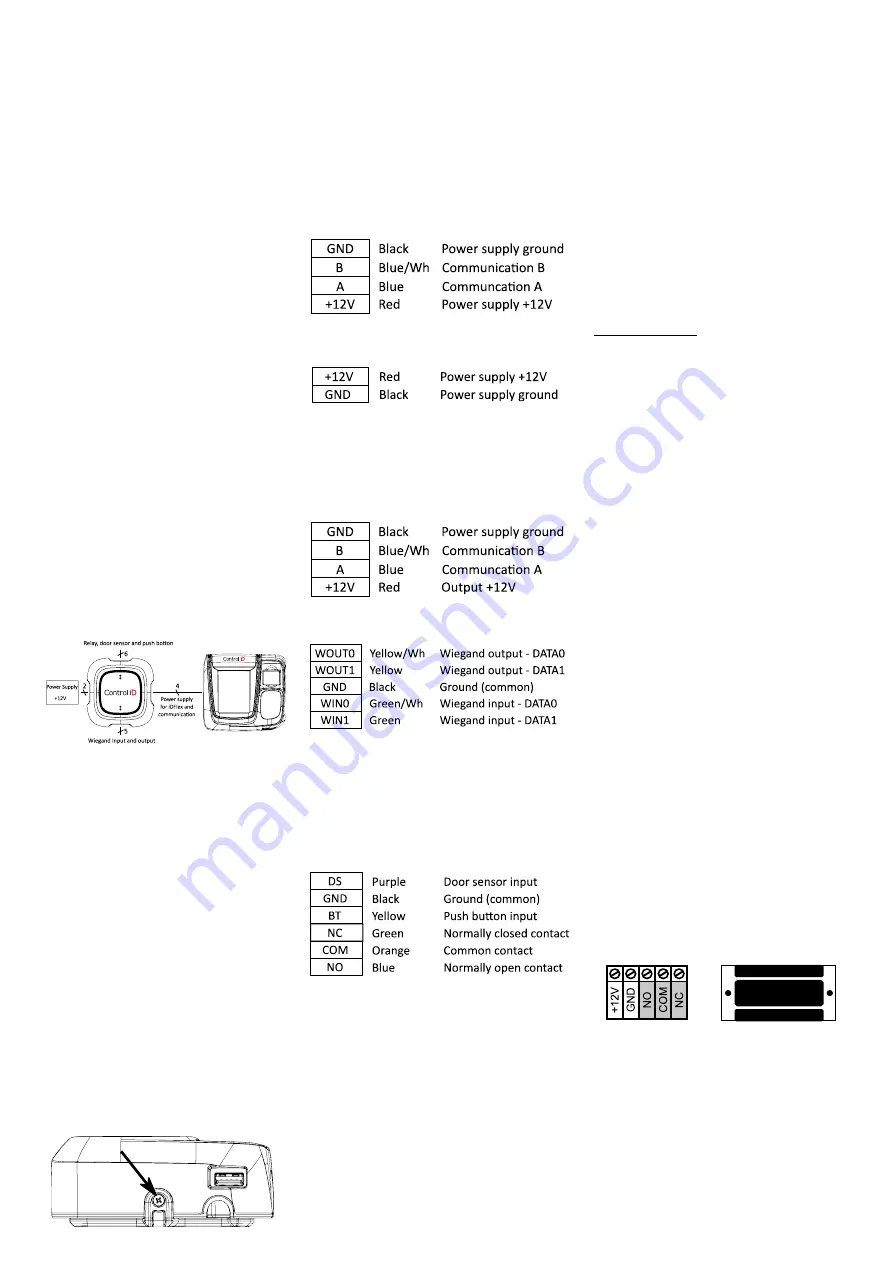
Quick Guide
–
iDFlex
–
Version 3.0 EN
–
Control iD 2020 ©
iDFlex
–
Quick Guide
Thank you for purchasing iDFlex! To access detailed
information about your new product, please check
the following link:
www.controlid.com.br/userguide/idflex-en.pdf
Necessary Materials
In order to install your iDFlex, you will need the
following items: drill, wall plugs and screws,
screwdriver or Philips, 12V power supply with at least
1A and an electronic lock.
Installation
For the correct operation of your iDFlex, the following
precautions should be taken:
•
Install in a place that is not exposed to direct
sunlight and that is protected from rain and
other natural phenomena.
•
Avoid metallic objects near the rear of the
device in order not to impair the proximity
reader’s r
ange. In case this is not possible, use
insulating spacers.
•
Fix the bottom part of the wall support for
iDFlex at 1.2m from the ground.
•
Before securing the device in place, ensure all
connecting cables are correctly routed towards
the device.
The device installation process is simple and should
follow the diagram below:
1.
For greater security during the installation, place
the External Access Module (EAM) in a secure
region (internal area of the facility)
2.
Use the reference pattern in the back of this
guide to drill the 3 holes required to install the
iDFlex and fit in the wall plugs.
3.
Connect the EAM to a +12V power source and to
the lock, using the cables supplied.
4.
Propose a 4
–
way cable long enough to connect
the EAM to the iDFlex. For distances that are
greater than 5m, use a twisted pair cable.
Remember to use the same pair for signals A and
B.
⚠
The EAM is responsible for powering iDFlex.
5.
Connect the wire harness provided with iDFlex to
the 4 wires in the previous item.
6.
Remove the wall support from the iDFlex.
7.
Screw the wall support with the wall plugs.
8.
Connect iDFlex to the 4-way wire harness
9.
Secure the iDFlex on the wall support and secure
it in place with the screws provided together with
the connection cables.
Description of the Connection Terminals
On your iDFlex, there is a connector on the back of the
device, besides the network connector (Ethernet). In
the External Access Module (EAM) there is a matching
connector and 3 other connecting pins that will be
used to connect locks, switches and scanners as
explained ahead.
iDFlex: 4 - Pin Connector
EAM: 2 - Pin Connector (Power Supply)
⚠
The connection to a +12V power supply with at
least 1A is fundamental for the correct operation of
the device.
EAM: 4 - Pin Connector
EAM: 5 - Pin Connector (Wiegand In/Out)
⚠
External card readers should be connected to
Wiegand WIN0 and WIN1. In case there is a control
board, one can connect the Wiegand WOUT0 and
WOUT1 outputs to the control board so that the
user´s ID identified in the iDFlex is transferred to it.
EAM: 6 - Pin Connector (Door Control/Relay)
⚠
The push button and door sensor inputs can be
configured as NO or NC and must be connected to dry
contacts (switches, relays etc.) between the GND and
respective pin.
iDFlex Settings
The configuration of all the parameters of your new
iDFlex can be set through the LCD display (Graphic of
user Interface
–
GUI) and/or through a standard
internet browser (as long as the iDFlex is connected
to an Ethernet network and has this interface).
In order to configure for example the IP address, subnet
mask and gateway, through the touch screen, follow
these steps:
Menu
→
Settings
→
Network
. Update the
information as you wish and connect the device to the
network.
Web Interface Settings
First, connect the device directly to a PC using an
Ethernet cable (cross or direct). Next, set a fixed IP on
your computer for network 192.168.0.xxx (where xxx is
different from 129 so that there is no IP conflict) and
mask 255.255.255.0.
To access the device settings screen, open a web
browser and enter the following URL:
http://192.168.0.129
The login screen will be shown. The default access
credentials are:
• Username:
admin
• Password:
admin
⚠
Through the web interface you can change the
device’s
IP. If you change this parameter, remember to
write down the new value so that you can connect to
the product again.
Electronic lock types
iDFlex, through the relay in the External Access Module,
is compatible with almost all of the locks available in the
market.
Magnetic lock
The magnetic or electromagnetic lock consists of a
coil (fixed part) and a metal part (armature plate)
which is attached to the door (mobile part). While
there is a current passing through the magnetic lock,
the fixed part will attract the mobile part. When the
distance between these two parts is small, ie. when
the door is closed and the dock is on top of the fixed
part, the attraction force between the parts can
reach over 1000kgf.
Thus, the magnetic lock is normally connected to the NC
contact of the activation relay, as we normally want for
the current to go through the electromagnet and, if we
want the door to open, the relay must open and
interrupt the current flow.
In this guide, the magnetic lock will be represented
by:
Electric bolt
The electric bolt lock, also known as solenoid lock,
consists of a fixed part with a mobile pin connected
to a solenoid. The lock normally comes with a metal
plate that will be attached to the door (mobile part).




















